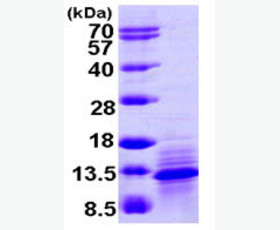Recombinant Human Interleukin-36γ/IL-36γ/IL-1F9
| Product name: | Recombinant Human Interleukin-36γ/IL-36γ/IL-1F9 |
| Source: | E.coli |
| Purity: | Greater than 95% as determined by reducing SDS-PAGE. |
| Buffer Formulation: | Lyophilized from a 0.2 μm filtered solution of 20mM Tris,100mM Nacl,0.1mM EDTA,pH8.0. |
| Applications: | Applications:SDS-PAGE; WB; ELISA; IP. |
| Storage: | Avoid repeated freeze/thaw cycles. Store at 2-8 oC for one month. Aliquot and store at -80 oC for 12 months. |
| UOM: | 100ug/50ug/200ug/1mg/1g |
| Source | E.coli |
| Description | Recombinant Human Interleukin-36 gamma is produced by our E.coli expression system and the target gene encoding Ser18-Asp169 is expressed. |
| Names | Interleukin-36 gamma, IL36G, IL-1-related protein 2, IL-1RP2, IL-1 epsilon, IL-1F9, Interleukin-1 homolog 1, IL-1H1 |
| Accession # | Q9NZH8 |
| Formulation | Lyophilized from a 0.2 μm filtered solution of 20mM Tris,100mM Nacl,0.1mM EDTA,pH8.0. |
| Shipping |
The product is shipped at ambient temperature. |
| Reconstitution |
Always centrifuge tubes before opening. Do not mix by vortex or pipetting. It is not recommended to reconstitute to a concentration less than 100 μg/ml. Dissolve the lyophilized protein in ddH2O. Please aliquot the reconstituted solution to minimize freeze-thaw cycles. |
| Storage |
Lyophilized protein should be stored at < -20°C, though stable at room temperature for 3 weeks. Reconstituted protein solution can be stored at 4-7°C for 2-7 days. Aliquots of reconstituted samples are stable at < -20°C for 3 months. |
| Purity |
Greater than 95% as determined by reducing SDS-PAGE. |
| Endotoxin | Less than 0.1 ng/µg (1 IEU/µg) as determined by LAL test. |
| Amino Acid Sequence |
SMCKPITGTINDLNQQVWTLQGQNLVAVPRSDSVTPVTVAVITCKYPEALEQGRGDPIYLGIQNP EMCLYCEKVGEQPTLQLKEQKIMDLYGQPEPVKPFLFYRAKTGRTSTLESVAFPDWFIASSKRDQ PIILTSELGKSYNTAFELNIND
|
| Background | Interleukin-36 gamma (IL-36γ) is a member of the interleukin 1 cytokine family that includes three closely related genes, IL-36α, β, and γ, formerly known as IL-1F6, F8, and F9 respectively. IL-36α has been detected in both neuronal and synovial tissue, whereas IL-36β and IL-36γ are expressed in both cutaneous and mucosal epithelial cells, including the respiratory tract. IL-36β and IL-36γ stimulate proliferation, maturation and/or cytokine expression by innate immune cells (such as keratinocytes and dendritic cells), and adaptive immune cells (neutrophils and T-cells) in both humans and mice. The activity of IL-36α is mediated by interleukin 1 receptor-like 2 (IL1RL2/IL1R-rp2), and is specifically inhibited by interleukin 1 family, member 5 (IL1F5/IL-1 delta). IL-36γ plays an important role in communicating the cell death to surrounding cells. |














